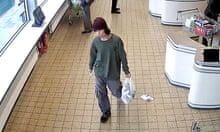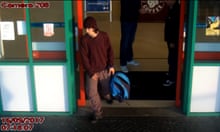Britain’s terror threat level has been raised from severe to critical, indicating a further attack may be imminent following the Parsons Green tube bombing, Theresa May has said.
The hunt is under way for the bomber who attempted to bring carnage to a London rush-hour tube train packed with schoolchildren and commuters.
Twenty-nine people including a young boy were injured when the bomb partially detonated and sent a ball of fire along a carriage of a District line train at Parsons Green, west London.
Police are understood to have found CCTV images that captured the bomber as he boarded the train with the bomb packed in a white plastic bucket inside a Lidl supermarket bag. The train is believed to have had onboard CCTV, and there are a large number of cameras covering the network.
Islamic State claimed responsibility for the blast, the militant group’s Amaq news agency said on Friday evening.
Nobody suffered life-threatening injuries in the incident, the fifth terrorist attack Britain has suffered in less than six months. Parsons Green station has since reopened.
In a televised statement on Friday night, the prime minister said the UK terror threat level was being raised to its highest rating and that armed police and members of the military would be seen on the streets in the coming days.
“For this period, military personnel will replace police officers on guard duties at certain protected sites that are not accessible to the public,” she said.
“The public will see more armed police on the transport network and on our streets, providing extra protection. This is a proportionate and sensible step which will provide extra reassurance and protection while the investigation progresses.”
The prime minister condemned Friday’s bombing as cowardly and the home secretary, Amber Rudd, denounced it as “callous and indiscriminate”. The London mayor, Sadiq Khan, described the attack as hideous and added: “We will never be defeated.”
The security minister Ben Wallace told the BBC on Saturday: “We haven’t been able at the moment to catch the bomber. The bomber is still out there – or bombers – and we have to get to the bottom of that and follow up the leads.”The Met assistant commissioner Mark Rowley, the UK’s most senior anti-terror police officer, said police were “chasing down suspects”. He said support from the military would free up about 1,000 extra armed police officers, largely from the Civil Nuclear Constabulary and Ministry of Defence police.
A former army bomb disposal officer said it appeared the initiating charge of the device had exploded but had failed to detonate the main charge.
Initially, police considered the possibility that the bomber had been among those taken to hospital, where many were treated for flash burns.
Investigators. however, believe the device was remotely detonated, which suggested it may not have been intended as a suicide attack, and that the bomber may have left the train before the explosion.
Donald Trump’s first response to the attack – a tweet in which he claimed the “loser terrorist” had been on Scotland Yard’s radar, and that more proactive policing was required – was dismissed by a police spokesman as “unhelpful”. May also criticised the US president, saying: “I never think it is helpful for anybody to speculate on what is an ongoing investigation.”
Another attack in London by a loser terrorist.These are sick and demented people who were in the sights of Scotland Yard. Must be proactive!
— Donald J. Trump (@realDonaldTrump) September 15, 2017
The explosion happened at about 8.20am on Friday while the train was stationary and the doors open.
Rory Rigney had just boarded the rear carriage of the train and was standing just feet away when the blast went off. “I thought: ‘Did someone smash something?’ It sounded like a smash, then I heard a scream and thought: ‘It’s someone having a fight.’ Then I saw the fireball coming towards me – yellow or orange. My face still feels warm.
“The doors were still open, so I jumped out and tried to get as far away as possible, got on the ground and covered myself. I wasn’t hanging around to get a better look at it.”
Chris Wildish, who was also on the train, said “a massive flash of flames” reached up to the ceiling of the train, and then the air was filled with the smell of chemicals. Many of the passengers were schoolchildren, who were knocked around by people trying to get away from the fire, he said.
Emma Stevie said people tumbled over each other as they tried to escape. “There were people on top of people. There was a pregnant lady under me shouting: ‘I’m pregnant’. There was a little boy in his red and black uniform, he must have been about eight years old, a tiny thing, with his face smashed into the steps.”
Before long, a number of people returned to the train to retrieve bags and telephones. A few took photographs of the smouldering remains of the device, which had been packed into a bucket that eyewitnesses said appeared to have held mayonnaise. A number of wires, which appeared to be attached to small lights, were also visible.
Tube staff then ordered people to leave the station. Armed police were on the scene within minutes, as were firefighters and paramedics, who began treating people with burns.
Police threw a cordon around the area and asked some residents to leave their homes. Armed police evacuated a nursery and a junior school, and a girls’ secondary school was placed in lockdown.
NHS England said 29 patients had been treated, with 21 still in hospital on Friday evening.
Responsibility for the investigation was quickly handed to Scotland Yard’s counter-terrorism command.
I'm safe - just had to run for my life at #ParsonsGreen station - huge stamped, lots injured. Not sure why - fire/explosion mentioned. pic.twitter.com/zRvRPWOuzA
— Emma (@EmmaStevie1) September 15, 2017
Rowley said hundreds of detectives had been drafted in to the investigation, and he appealed to the public for information.
So far, 77 images and videos have been sent to investigators via the UK Police Image Appeal website.
Still unclear but very scary - extremely heavy armed police presence now #ParsonsGreen pic.twitter.com/WkodyNsfk0
— Alex Littlefield (@A_Littlefield) September 15, 2017
On Friday night detectives were examining a mass of CCTV footage from the underground rail network, and from businesses around some District line stations.
The device was being examined by forensics experts, and may offer clues from its construction and from the chemicals used to make the explosive charge.
Counter-terrorism investigators will want to establish where the device was put together, and where the materials to make it were acquired. They will also be attempting to establish whether the bomb-making knowledge was acquired from the plethora of DIY guides on the internet, or from another person.

Rita Katz, the director of the private intelligence company Site, said Isis claimed the bombing was the work of a “detachment” rather than simply a “soldier”, which she said implied it was a co-ordinated attack.
The terror group has frequently declared that it was behind terrorist incidents in recent years but experts have warned that its claims should be treated with caution.
The explosion at Parsons Green is the first terrorist attack in the UK this year to not result in loss of life. Two vehicle and knife attacks in London and a bombing in Manchester were blamed on Islamist-motivated terrorism. A van attack in June was blamed on an extreme rightwing motivation.
Hans Michels, a professor of safety engineering at the chemical engineering department at Imperial College London, said there appeared to be similarities with the failed attempts on 21 July 2005 to bomb the tube network.
“In appearance and arrangement the remnants of the device seem highly similar to those of the hydrogen peroxide-based devices of 2005. The size of the device and its containment in a plastic bucket is also the same.”
The trial of the 21 July bombers heard that their devices had failed because they had made mistakes when mixing the chemicals.
Additional reporting: Sarah Marsh, Kevin Rawlinson and Patrick Greenfield








